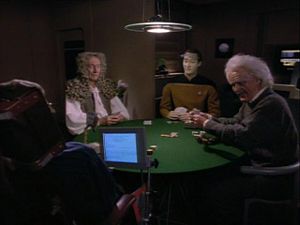
Posting has been light lately because we’ve been busy working on several projects, but we’re kicking things back into gear now.
Picking up on my last post, I want to comment on another passage from Ed Regis’s Great Mambo Chicken and the Transhuman Condition. Regis explains how Hans Moravec imagined bringing back to life people who have been long gone:
It ought to be possible, Moravec thought, to resurrect past history, or at least to resurrect some of the important historical figures — Isaac Newton, for example. In fact, Moravec had already figured out how to do this by the time he’d written Mind Children. He’d worked out a whole scenario whereby a powerful enough supercomputer would be able to resurrect long-dead minds from the information that still survived. You might be able to get Isaac Newton back from an edition of Principia Mathematica, plus what flimsy disturbances might remain in the air from the words Newton had actually spoken during his lifetime.
This was a bit of a stretch, admittedly, but nothing absolutely impossible, at least not in Hans Moravec’s view. After all, plenty of archaeologists had made a living by reconstructing entire cultures from pottery shards, scraps of ancient documents, X-ray scans of mummified remains, and so on, so why shouldn’t the superintelligences of the future be able to go far beyond this, to the point “where long-dead people can be reconstructed in near-perfect detail at any stage of their life,” as Moravec put it? [pages 262-3]
Let’s clear something up right away: It would not be possible to learn anything about anyone who lived before the age of audio recording technology by literally reconstructing the “flimsy disturbances” that “might remain in the air” from words that person had actually spoken. (While people have half-seriously talked about this sort of thing for decades, anyone with a basic understanding of physics will understand why it isn’t possible. A decade ago, there was an X-Files episode about some drying pottery that had been in the room when Jesus raised Lazarus from the grave; supposedly, the soundwaves from His voice had been recorded on a bowl and could be played back like a vinyl record. A similar idea, minus the resurrection, was at the heart of an April Fool’s joke that got lots of people talking back in 2006, inspiring the Mythbusters TV show to attempt an experiment.)
But it isn’t clear that Moravec was actually considering anything along these lines. The “flimsy disturbances” that Regis refers to were probably figurative, and the relevant section of Moravec’s book Mind Children doesn’t mention centuries-old sound waves. If you want to accurately simulate a historical figure, here are the sources of information that Moravec suggests consulting to make your simulation more accurate:
the person’s genetic code, for instance, or filmstrips of the person in life, samples of handwriting, medical records, memories of associates, and so on….
But what if no tape [that is, no recording of a person’s “pattern-identity”] existed at all? Archaeologists today make plausible inferences about historical figures from scraps of old documents, pottery shards, x-ray scans of mummified bodies, other known historical facts, general knowledge about human nature, and whatever else they can find…. Superintelligent archaeologists armed with wonder-instruments (that might, for instance, make atomic-scale measurements of deeply buried objects) should be able to carry this process to a point where long-dead people can be reconstructed in near-perfect detail at any stage of their life. [pages 122-3]
Moravec overreaches so often in Mind Children that stuff like this seems pretty tame in contrast to his trippier ideas. But it’s still worth pointing out just how preposterous even this stuff is.
Let’s work through it. Moravec proposes that the essence of who you are as a person is your “pattern-identity,” which, he imagines, can be digitally stored for future retrieval and even uploaded into robot.
In Moravec’s future, for any given pattern-identity, there are three logical possibilities: either it is preserved as a program entirely, partially, or not at all.
If yours is preserved entirely, you’re in luck — you can be popped into a robo-body and live indefinitely.
If yours is preserved partially, perhaps the missing parts — just “temporarily diffused in the environment,” as Moravec puts it — can be reconstructed from filmstrips, handwriting, and so forth.
And if yours is not at all digitally stored, well, a computer will have to make everything up based on whatever clues are available, just as “creators of historical fiction” gin up fictional accounts of the past. Isn’t it obvious, though, that a simulation of a long-dead person like Isaac Newton cannot be reconstructed in “near-perfect detail,” as Moravec claims? Such a simulation might be fun for educational or recreational purposes (click the picture at right) but the information underlying it would have such enormous gaps that the simulation would be more a caricature of Newton than an accurate representation. And even the extant information could be interpreted lots of different ways; the raw facts of history take us only so far, which is why historians (and authors of historical fiction) are forever debating. This is why there are so many biographies of, for example, Abraham Lincoln: not because new facts are discovered that necessitate new accounts of his life, but because there are so very many ways of interpreting the facts already known. And for more obscure historical figures, of course, the historical record would be so thin that the guesswork would be even greater: imagine trying to simulate, say, Newton’s mother.
More importantly, the historical record available for reconstructing a person is mostly a collection of external facts about a life — which is to say, it leaves out crucial internal aspects of human being. To understand what I mean, watch this clip from the new TV series Caprica. In the pilot episode, the following conversation takes place between a simulation of the late Zoe Graystone and an avatar of her father (while another girl’s avatar looks on).
The flesh-and-blood Zoe Graystone is dead, but this simulation claims to be accurate because it, the simulation, is based on so many sources of data.
But what do those sources of data reveal? Some might tell you a bit about the health and appearance of the body. (“DNA profiles” and “genetic typings” are both mentioned, which seems repetitious, as does “medical scans” and “CAT scans.”) Some might tell you about physical appearance, mannerisms, and sound. (“Recording — video, audio” and “security cameras.”) But what do movie tickets reveal about you? Only that you might have attended particular movies — not why you attended or what you thought of the movies. What do your e-mails reveal? Only what you wanted other people to read, which might or might not reflect what you actually think or feel. And so on. With the possible exception of “synaptic records,” which don’t exist in real life (and even if they did would not be translatable into mental states), everything on Zoe’s list offers only fragmentary, potentially misleading, external information. Using all that data, it might be possible to develop an interesting psychological profile of a person, and perhaps even very crudely to ape a person. But excluded would be everything that is internal and not reducible to data: the varied intensity of authentic feeling; the creative spark; the ever-shifting web of relations with others; the ever-present secrets of pride, shame, and love; and the potential of growth of the inner-directed consciousness.


I still can't believe they got Isaac Newton to come on that show.